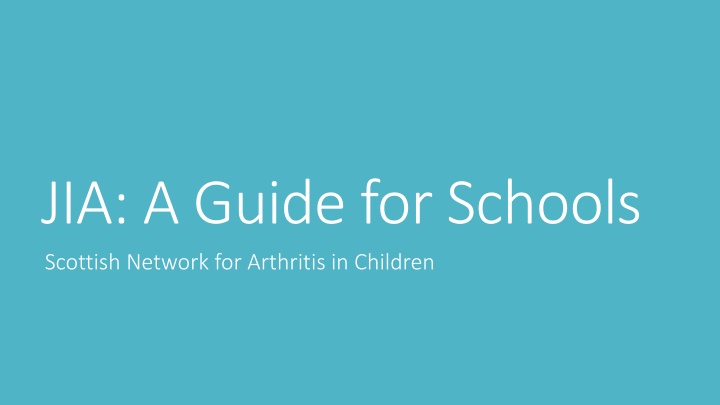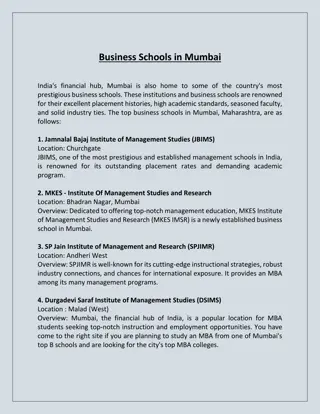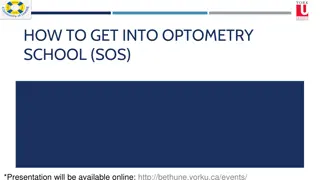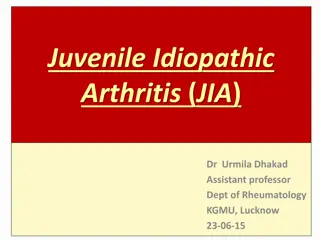JIA: A Guide for Schools
JIA, standing for Juvenile Idiopathic Arthritis, is a chronic condition affecting children under 16. Symptoms vary, requiring careful management with contemporary treatments. Supporting JIA pupils at school involves being attentive, patient, and flexible to cater to their needs.
Download Presentation

Please find below an Image/Link to download the presentation.
The content on the website is provided AS IS for your information and personal use only. It may not be sold, licensed, or shared on other websites without obtaining consent from the author.If you encounter any issues during the download, it is possible that the publisher has removed the file from their server.
You are allowed to download the files provided on this website for personal or commercial use, subject to the condition that they are used lawfully. All files are the property of their respective owners.
The content on the website is provided AS IS for your information and personal use only. It may not be sold, licensed, or shared on other websites without obtaining consent from the author.
E N D
Presentation Transcript
JIA: A Guide for Schools Scottish Network for Arthritis in Children
Understanding JIA JIA stands for Juvenile Idiopathic Arthritis Juvenile Idiopathic Arthritis. Juvenile Juvenile: It affects children and adolescents under the age of 16. Idiopathic Idiopathic: It has no known cause. Arthritis Arthritis: It is a chronic (long-lasting) inflammation of the joints. JIA affects about 1 in every 1,000 children in Scotland.
Symptoms Symptoms The symptoms of JIA vary widely in kind and severity. Most children with JIA will endure some stiffness and soreness in their joints. Other symptoms associated with the condition include: Fatigue Insomnia Mood swings Mental fog/difficulty concentrating A complex and dynamic condition JIA is not a simple condition. There are several distinct types of JIA, each with its own characteristic symptoms, effects, and treatments. And kids with JIA will find that their experience of the condition changes over time. We like to put it this way: Every child with JIA is different, and every day with JIA is different.
JIA Treatments JIA Treatments Contemporary treatments for JIA usually prove highly effective, but the condition requires quite careful management. Some of the medications used to treat JIA have unwelcome side- effects, including nausea, fatigue, and an increased susceptibility to infection. Lost weekends Many JIA children require weekly injections of methotrexate a powerful disease-modifying drug commonly used in the treatment of JIA. Methotrexate can cause severe fatigue and nausea, and so parents often give their children these injections on the weekend so they will not miss school. But missing out on part of the weekend also comes at a cost.
Supporting JIA pupils at school Be Be attentive: attentive: JIA is an invisible condition ; its effects are not always immediately obvious and kids with JIA might not always admit they are feeling sick, sore, or tired. It is vital for teachers to keep open lines of communication so students with JIA will feel free to speak up when they need a break, a little extra help, or just to talk. Be patient: Be patient: JIA causes physical and mental fatigue, and children with JIA can find it difficult to keep up with their peers both in the classroom and on the playground. They will get there, but it might take a bit longer! Be flexible: Be flexible: The symptoms of JIA can change from day to day and throughout each day. Teachers rightly should have high expectations of all their students including children with JIA! but they also should expect students with JIA to require special treatment from time to time. It is important to note that this does not mean JIA children should be wrapped in cotton wool; they do not want to be singled out or treated as other than normal.
Attendance Children with JIA have virtually no chance of having a perfect attendance record. They will miss school for two main reasons: Medical appointments: JIA is not an easy condition to diagnose and treat. Children with JIA are required to meet regularly with their rheumatology team, and they may also be expected to attend orthopaedic and physiotherapy sessions; undergo eye exams and diagnostic scans; and receive blood tests, injections, and infusions. JIA-related symptoms: It is not always easy to live with JIA. Children with the condition may be slow to start in the morning and endure pain, stiffness and fatigue throughout the day. In addition, they will experience times when their condition flares ---when their symptoms are especially severe. Schools should be alert to the academic and social impact on students with JIA of their planned and unplanned absences from school.
Providing practical support Fatigue is a real issue; allow rest breaks as required, and be sure a chair or cushion is available for kids to sit at assembly or story time. It can be difficult for JIA kids to navigate stairs or carry heavy loads; provide access to a locker for books and bags, and to a lift if available. Also allow extra time to move between classes. JIA can be a painful condition; provide access to pain relief medication, and allow movement breaks to help alleviate stiffness. Children with JIA may be absent more often than other kids; provide homework plans or other guidance to help them keep up with their schoolwork.
Providing emotional and social support Children with JIA can experience lethargy, anxiety, and mood swings; be sure to listen carefully when they want to talk about their experiences but don t force them to do so. Remember that in most respects kids with JIA are just like everyone else and they want to be treated that way. If a pupil requires JIA medication or treatment at school, be sure to provide privacy. Students with JIA need to learn to manage their own condition; let them decide whether or not they can participate in sports activities, require rest breaks, and so on. Be alert to the ways in which other children in the school may be relating to someone with JIA.
Communication is key Perhaps the most important thing a school can do to support a student with JIA is to ensure that they stay in continual two-way communication with the student and their parents/carers. How they do so will vary from case to case, but many schools may wish to: Invite the pupil, their parents/carers, and perhaps also a member of the pupil s medical team to have a chat with the pupil s teacher(s), the school nurse, and other relevant members of the school staff. Agree upon a care plan (including reasonable adjustments if necessary) that will provide a basis for future conversations. Identify key points of contact and the most efficient and effective means of ongoing communication (e.g., phone, email, regular meetings, home-school diary).
For more information For more information To find out more about JIA and about the resources available to children and families in Scotland affected by the condition, visit www.snac.uk.com. About SNAC Scottish Network for Arthritis in Children (SNAC) is a charity with a single overriding purpose: to provide factual, practical, and emotional support for children and families across Scotland who are living with JIA.























